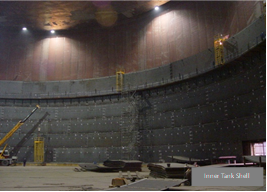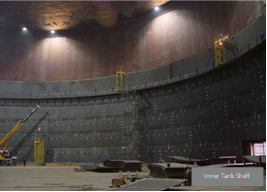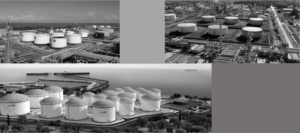Steels Used for LNG Tanks
By: Dr. Eng. Pablo Ozaeta L.
1. LNG tank:
Natural gas is transported by pipelines at high pressure, LPG, where the maximum rentable length is around dozens of thousands of kilometers or at low temperature and ambient pressure by LNG sea carriers, where natural gas could be transported for longer distances than LPG technology.
At both sides of LNG production chain, the product should be temporally in storage; after liquefaction, while is waiting to be charged on LNG carriers, and at the receiver side, while it is waiting to be processed in the regasification plant. This temporal storage of Natural Gas is made in liquid state at a temperature below -165ºC in LNG tanks, which are designed like huge multi-layer thermos, with a few insulator layers placed between different structural parts of the tank.
1.1.1 Base metal:
Carbon steels and most ferritic materials change from ductile to brittle below certain temperature, which depends on the chemical composition, heat treatment and material thickness, this temperature is called “Transition Temperature”.
This natural characteristic means that ferritic materials are not used in applications at temperatures below -80ºC. The heat-treated 9% nickel steels have good toughness at temperatures below -196°C, along with a high mechanical-strength. There are two 9%Ni steels, the ASTM A353, which is double normalized and tempered, and the ASTM A553, which is quenched and tempered. The A553 T1 steel has a microstructure consisting of tempered martensite, bainite, and about 4% of stable austenite obtained during tempering of the steel just above the austenite transformation temperature.
These steels have good weldability, so any of the common welding processes, such as, SMAW, GTAW, FMAW and SAW, could be used to weld them. Although SMAW and SAW are the most frequently used welding processes; FCAW, however, has shown good performance in recent years.

9%Ni steel tends to be easily magnetized, staying magnetized for a while. Residual magnetism doesn’t represent any issue for the steel per se. The problem, however, arises during welding by any electric arc procedure, which produces “Arc Blow”. This produces imperfections and discontinuities in the welded metal.
The big problem of residual magnetism is controlled by avoiding the exposition of the material to any magnetic field, making sure the material isn’t handled by magnetic manipulators and assuring the transporting trucks are not parked below high-tension electric conduction lines at any time.




